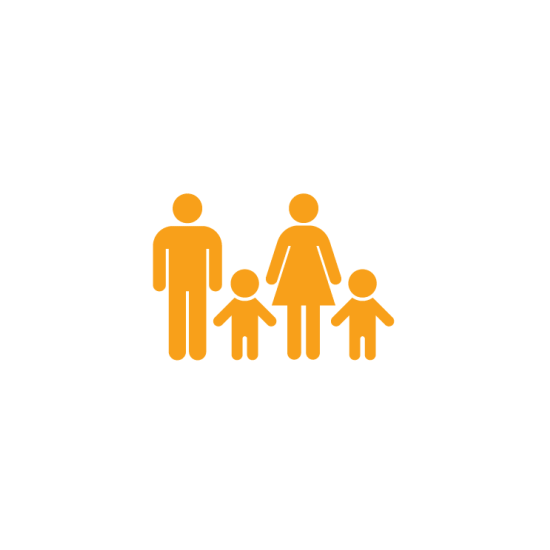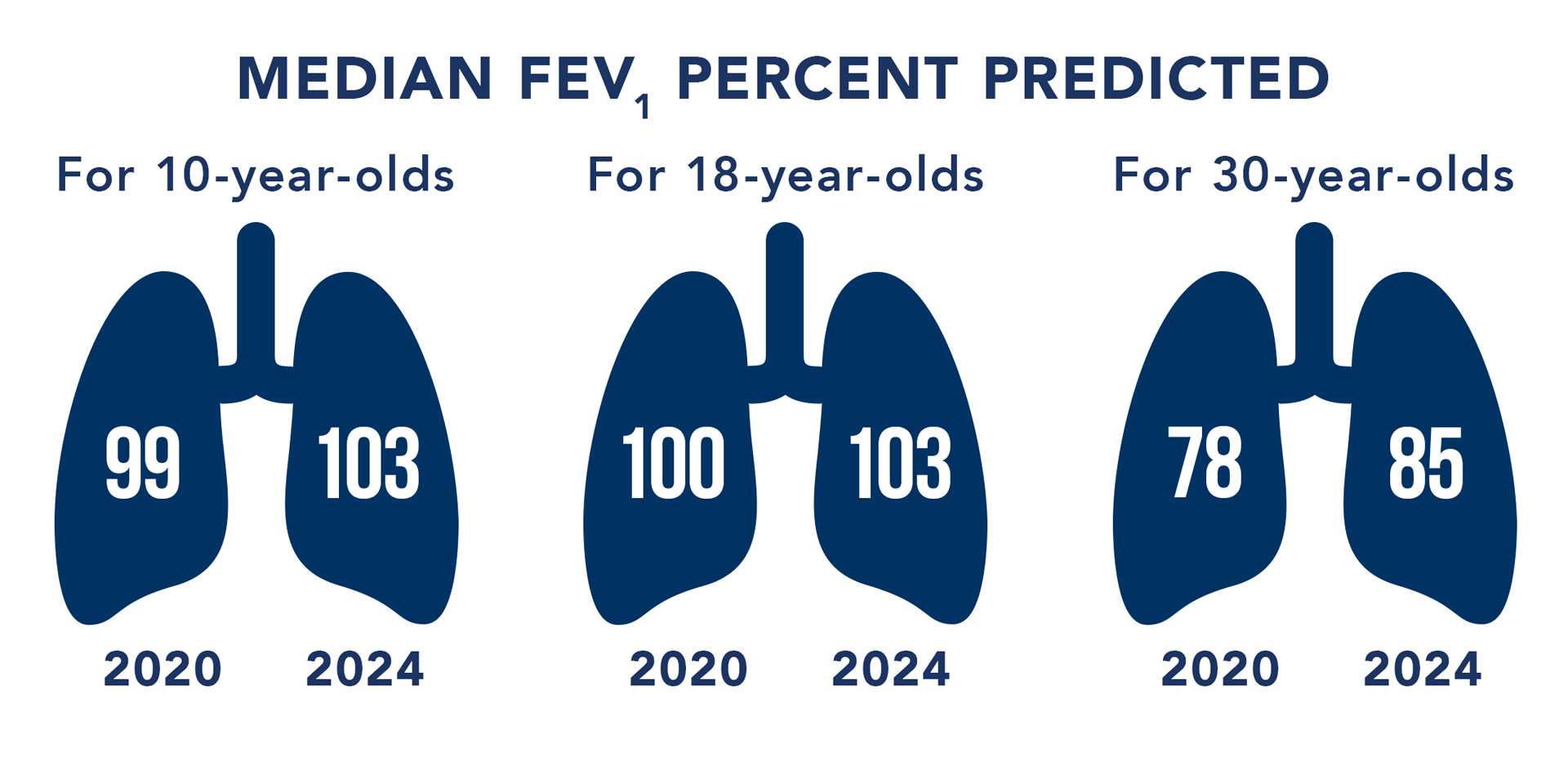This report offers key insights from last year’s CF Foundation Patient Registry data. The Registry includes data from people with CF in the United States who visit CF care centers and agree to participate in the Registry. Every year, the report shows how far science, care, and community support have taken us, and how much work remains to improve outcomes for all people with CF.
Registry by the Numbers

“Thanks to dramatic advances in CF care over the past decade, we continue to see people with CF live longer and healthier lives. Still, we remain laser-focused on developing transformative treatments for all people with CF and addressing the wide range of health challenges people with CF face as they age.”
— Michael P. Boyle, MD, president and CEO, CF Foundation
Lung Function
Lung function is a primary indicator of health for people with CF. FEV₁, a measure of lung function, is the forced exhaled volume of air in the first second of an exhaled breath. It is shown as a percent predicted based on the FEV₁ of healthy, nonsmoking people of the same age, height, and gender.
Lung Transplants
In the Registry, there has been a dramatic decrease in the number of lung transplants reported compared to the numbers prior to the approval of Trikafta in 2019. In 2024, a total of 61 lung transplants were reported, 19 of which were re-transplants.

“While the number of people with CF undergoing lung transplants continues to decrease each year, there are more than 1,700 people with CF living post-transplant. We think of these individuals every day as we work toward improving lung transplant outcomes and furthering research on transplant complications.”
— Albert Faro, MD, senior vice president and chief medical officer, CF Foundation
Exacerbations
PEOPLE WITH CF WITH ONE OR MORE PULMONARY EXACERBATION
Pulmonary exacerbations (when lung symptoms worsen) may be treated with IV antibiotics. The percent of people with CF treated with IV antibiotics has decreased since 2019.
Median Survival Age
Among people with CF born between 2020 and 2024, half are predicted to live to age 65 or beyond. However, this does not reflect individual variability. The median survival is lower — by possibly more than a decade — for those who are ineligible for CFTR modulators. Remarkably, the historically lower survival among females has improved significantly and is now only slightly below that of males.

“There are many factors driving the continued increase in the median age of survival for people with CF. Improvements in the diagnosis of CF, expansion of the CF care model, the evolution of guideline-based CF care, improvements in management of infection, increased screening for CF-related complications, and CFTR modulator therapies have all played a role.”
— Albert Faro, MD, senior vice president and chief medical officer, CF Foundation
Number of People With CF by Age Over Time
The number of people with CF over the age of 50 is steadily increasing. Advances in care and research, particularly the development of modulator therapies, have dramatically improved life expectancy and quality of life. As a result, more individuals with CF are living longer, healthier lives, transitioning into middle age and beyond — a milestone that was once rare in the CF community.
Click the play button under the graph to see changes over time.
Mental Health
The percent of people with CF age 12 years and older with reported depression or anxiety.

Milestones
People with CF continue to transition toward greater independence at school and beyond.

65% of adults with CF have full-time or part-time jobs.

41% of adults with CF have a college degree.
Race and Ethnicity of People With CF
The CF population is growing more diverse every year. In 2024, more than 23% of people newly diagnosed with CF identified as Hispanic, Black, multiracial, Asian, or another race or ethnicity other than white.
CTFR Modulator Eligibility and Use
Since 2012, when the first CFTR modulator — Kalydeco — was approved, modulator therapy has transformed CF care. Over time, newer treatments like Orkambi, Symdeko, and especially Trikafta have significantly expanded both eligibility and impact. Today, a large proportion of people with CF are on modulators, with Trikafta dominating recent years. Despite this, in 2024, 7.3% of people with CF were still not eligible for any CFTR modulator due to their age or genotype. The data also reveal important nuances: some people are eligible but not taking modulators, a small number are using them off-label, and others remain ineligible or have unknown status. Use the arrows above the chart to explore changes in modulator use across different years.
Common CF Infections
Many infections are especially dangerous for people with CF and may lead to a faster decline in lung function.






Health Insurance
For many people with cystic fibrosis, dealing with insurance is as much a part of living with the disease as are nebulizers and vests.

60% of all people with CF are on a private insurance plan.

50% of adults with CF 18–25 years are on their parents' insurance plan.

13% of adults with CF 18–64 years are on Medicare.

36% of all people with CF are on Medicaid.

52% of children with CF under 10 years are on Medicaid.
Diabetes in People With CF
In 2024, 24% of people with CF were identified as having CF-related diabetes, and 1% were diagnosed with Type 1 or Type 2 diabetes. Over the past 10 years, the percentage of individuals age 10 and older with CFRD has remained remarkably stable, ranging between 23.5% and 26%.
Colonoscopy Screenings
The risk for colorectal cancer in adults with cystic fibrosis is 5–10 times greater than the general population, and even higher for people with CF who receive a lung or other solid organ transplant. Early screening can help reduce this risk. The below data reflect screenings and diagnoses from 2020 to 2024.

Total Screened
people received colonoscopies

Detected Cases
colon cancer diagnoses

Screening Rate
of eligible individuals screened
Number of People With CF in the Registry by State
This graph offers a look at where people with CF live in the U.S.
Weight Status Over Time
Over the last 20 years, the percentage of people with CF who are overweight or obese has increased — from 10% to 21% among children with CF and from 18% to 43% among adults.
Number of Pregnancies Over Time
Pregnancy data in the Registry is collected annually. Because some pregnancies span two calendar years, they may be reported in both years — once when they begin and again if still ongoing the next year. This can lead to some pregnancies being counted more than once. In this chart, a "new pregnancy" means the woman did not have a pregnancy reported in the Registry in the previous year.
Thank you to all the CF care teams who enter data into the Registry, and to all the people with CF and all the families who have graciously agreed to share their data with the Cystic Fibrosis Foundation.
SOURCE DATA
Cystic fibrosis patients under care at CF Foundation-accredited care centers in the United States, who consented to have their data entered.
CITATION
2024 Cystic Fibrosis Foundation Patient Registry Highlights
Bethesda, Maryland
© 2025 Cystic Fibrosis Foundation

